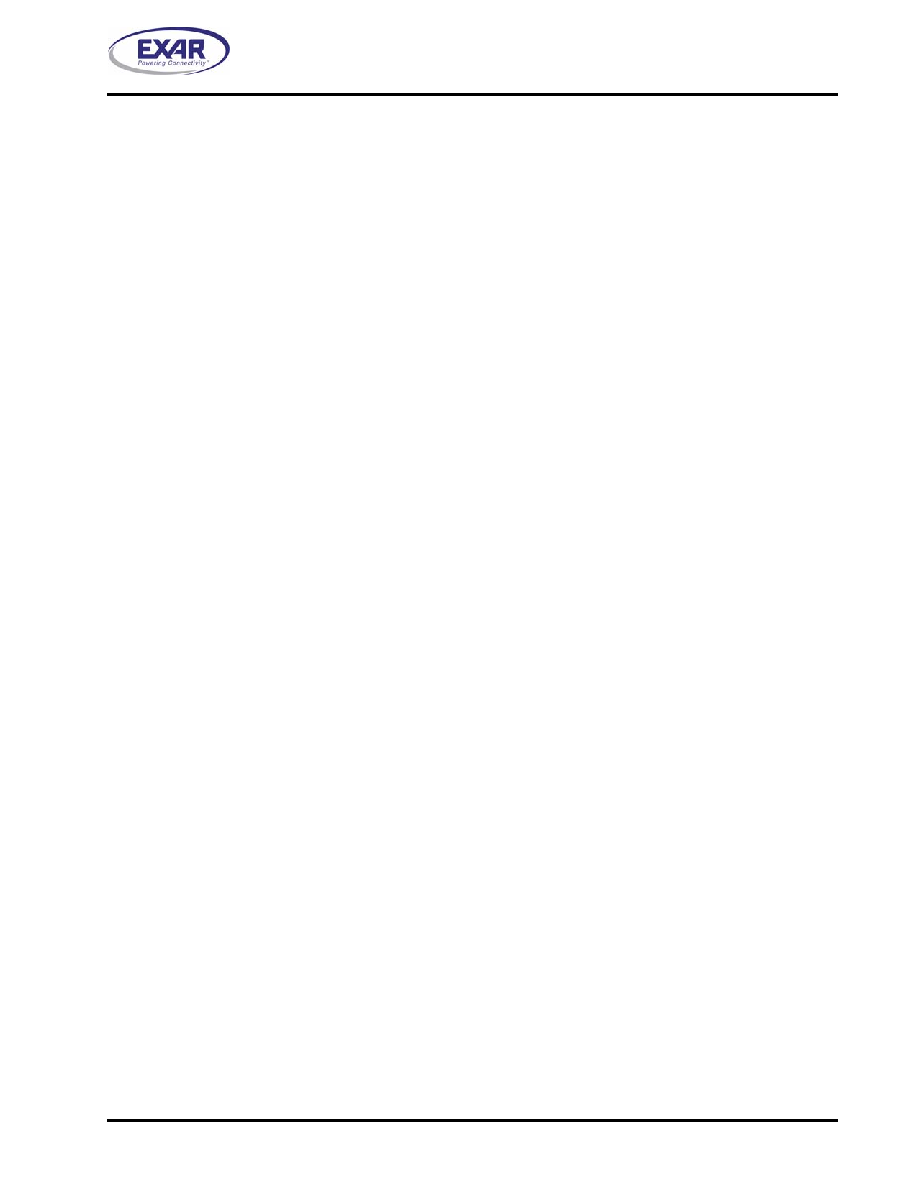- 您現(xiàn)在的位置:買賣IC網(wǎng) > PDF目錄16433 > XR16V698IQ-0A-EVB (Exar Corporation)EVAL BOARD FOR XR16V698-A 100QFP PDF資料下載
參數(shù)資料
| 型號(hào): | XR16V698IQ-0A-EVB |
| 廠商: | Exar Corporation |
| 文件頁(yè)數(shù): | 27/58頁(yè) |
| 文件大小: | 0K |
| 描述: | EVAL BOARD FOR XR16V698-A 100QFP |
| 標(biāo)準(zhǔn)包裝: | 1 |
| 系列: | * |
第1頁(yè)第2頁(yè)第3頁(yè)第4頁(yè)第5頁(yè)第6頁(yè)第7頁(yè)第8頁(yè)第9頁(yè)第10頁(yè)第11頁(yè)第12頁(yè)第13頁(yè)第14頁(yè)第15頁(yè)第16頁(yè)第17頁(yè)第18頁(yè)第19頁(yè)第20頁(yè)第21頁(yè)第22頁(yè)第23頁(yè)第24頁(yè)第25頁(yè)第26頁(yè)當(dāng)前第27頁(yè)第28頁(yè)第29頁(yè)第30頁(yè)第31頁(yè)第32頁(yè)第33頁(yè)第34頁(yè)第35頁(yè)第36頁(yè)第37頁(yè)第38頁(yè)第39頁(yè)第40頁(yè)第41頁(yè)第42頁(yè)第43頁(yè)第44頁(yè)第45頁(yè)第46頁(yè)第47頁(yè)第48頁(yè)第49頁(yè)第50頁(yè)第51頁(yè)第52頁(yè)第53頁(yè)第54頁(yè)第55頁(yè)第56頁(yè)第57頁(yè)第58頁(yè)

XR16V698
33
REV. 1.0.3
2.25V TO 3.6V HIGH PERFORMANCE OCTAL UART WITH 32-BYTE FIFO
IER[7]: CTS# Input Interrupt Enable (requires EFR bit-4=1)
Logic 0 = Disable the CTS# interrupt (default).
Logic 1 = Enable the CTS# interrupt. The UART issues an interrupt when CTS# pin makes a transition from
LOW to HIGH.
IER[6]: RTS# Output Interrupt Enable (requires EFR bit-4=1)
Logic 0 = Disable the RTS# interrupt (default).
Logic 1 = Enable the RTS# interrupt. The UART issues an interrupt when RTS# pin makes a transition from
LOW to HIGH.
IER[5]: Xoff Interrupt Enable (requires EFR bit-4=1)
Logic 0 = Disable the software flow control, receive Xoff interrupt (default).
Logic 1 = Enable the software flow control, receive Xoff interrupt. See Software Flow Control section for
details.
IER[4]: Reserved
IER[3]: Modem Status Interrupt Enable
The Modem Status Register interrupt is issued whenever any of the delta bits of the MSR register (bits 3:0) is
set.
Logic 0 = Disable the modem status register interrupt (default).
Logic 1 = Enable the modem status register interrupt.
IER[2]: Receive Line Status Interrupt Enable
An Overrun error, Framing error, Parity error or detection of a Break character will result in an LSR interrupt.
The 698 will issue an LSR interrupt immediately after receiving a character with an error. It will again re-issue
the interrupt (if the first one has been cleared by reading the LSR register) when the character with the error is
on the top of the FIFO, meaning the next one to be read out of the FIFO.
For example, let’s consider an incoming data stream of 0x55, 0xAA, etc and that the character 0xAA has a
Parity error associated with it. Let’s assume that the character 0x55 has not been read out of the FIFO yet. The
698 will issue an interrupt as soon as the stop bit of the character 0xAA is received. The LSR register will have
only the FIFO error bit (bit-7) set and none of the other error bits (Bits 1,2,3 and 4) will be set, since the byte on
the top of the FIFO is 0x55 which does not have any errors associated with it. When this byte has been read
out, the 698 will issue another LSR interrupt and this time the LSR register will show the Parity bit (bit-2) set.
Logic 0 = Disable the receiver line status interrupt (default).
Logic 1 = Enable the receiver line status interrupt.
IER[1]: TX Ready Interrupt Enable
In non-FIFO mode, a TX interrupt is issued whenever the THR is empty. In the FIFO mode, an interrupt is
issued twice: once when the number of bytes in the TX FIFO falls below the programmed trigger level and
again when the TX FIFO becomes empty. When auto RS-485 mode is enabled (FCTR bit-5 = 1), the second
interrupt is delayed until the transmitter (both the TX FIFO and the TX Shift Register) is empty.
Logic 0 = Disable Transmit Ready Interrupt (default).
Logic 1 = Enable Transmit Ready Interrupt.
相關(guān)PDF資料 |
PDF描述 |
|---|---|
| KIT33972AEWEVBE | KIT EVALUATION FOR MC33972 |
| EBM31DCMS | CONN EDGECARD 62POS .156 WW |
| VI-J1L-EX | CONVERTER MOD DC/DC 28V 75W |
| XR16V598IQ-0B-EVB | EVAL BOARD FOR XR16V598-A 100QFP |
| CM322522-820KL | INDUCTOR 82UH 60MA SMD |
相關(guān)代理商/技術(shù)參數(shù) |
參數(shù)描述 |
|---|---|
| XR16V698IQ-0B-EVB | 功能描述:UART 接口集成電路 Supports V698 100 ld QFP, PCI Interface RoHS:否 制造商:Texas Instruments 通道數(shù)量:2 數(shù)據(jù)速率:3 Mbps 電源電壓-最大:3.6 V 電源電壓-最小:2.7 V 電源電流:20 mA 最大工作溫度:+ 85 C 最小工作溫度:- 40 C 封裝 / 箱體:LQFP-48 封裝:Reel |
| XR16V698IQ100 | 制造商:EXAR 制造商全稱:EXAR 功能描述:2.25V TO 3.6V HIGH PERFORMANCE OCTAL UART WITH 32-BYTE FIFO |
| XR16V698IQ100-F | 功能描述:UART 接口集成電路 UART RoHS:否 制造商:Texas Instruments 通道數(shù)量:2 數(shù)據(jù)速率:3 Mbps 電源電壓-最大:3.6 V 電源電壓-最小:2.7 V 電源電流:20 mA 最大工作溫度:+ 85 C 最小工作溫度:- 40 C 封裝 / 箱體:LQFP-48 封裝:Reel |
| XR16V698IQ100TR-F | 制造商:Exar Corporation 功能描述:UART 8-CH 32Byte FIFO 2.5V/3.3V 100-Pin PQFP T/R 制造商:Exar Corporation 功能描述:XR16V698IQ100TR-F |
| XR16V794 | 制造商:EXAR 制造商全稱:EXAR 功能描述:HIGH PERFORMANCE 2.25V TO 3.6V QUAD UART WITH FRACTIONAL |
發(fā)布緊急采購(gòu),3分鐘左右您將得到回復(fù)。